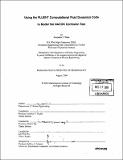Using the FLUENT computational fluid dynamics code to model the NACOK corrosion test
Author(s)
Parks, Benjamin T
DownloadFull printable version (28.15Mb)
Alternative title
Using the FLUENT CFD code to model the NACOK corrosion test
Other Contributors
Massachusetts Institute of Technology. Dept. of Nuclear Engineering.
Advisor
Andrew C. Kadak and Sidney Yip.
Terms of use
Metadata
Show full item recordAbstract
As a part of advancing nuclear technology, computational fluid dynamics (CFD) analysis offers safer and lower-cost results relative to experimental work. Its use as a safety analysis tool is gaining much broader acceptance due to increasing experimental verification. FLUENT is a Computational Fluid Dynamics (CFD) code that offers extensive benchmarks and validations, and is widely accepted by the nuclear engineering community. The Modular Pebble Bed Reactor (MPBR) is among the advanced reactor designs proposed for future deployment. As such, it offers an excellent opportunity to illustrate the possible contributions of computational modeling to the reactor design process. Because the MPBR contains graphite structures and fuel elements, there is significant concern about graphite heating and chemical reactions during an air ingress accident. Some MPBR-relevant experimental safety assurances have been benchmarked using FLUENT. Currently, there is a planned experiment involving natural convection flow and graphite corrosion at the Forschungzentrum Julich in Julich, Germany. Thus far, only a preliminary test of this experiment has been performed. This test has been called the NACOK Corrosion Test, and this thesis presents a model of the test configuration. (cont.) A methodology is developed by which an efficient analysis of the flow, heat transfer, and corrosion effects of the test are modeled using the FLUENT software. An adequate grid resolution is determined that allows computationally efficient analysis. Steady-state and transient flow and heat transfer effects are modeled, and separate models contain steady-state and transient chemistry effects. The steady-state flow and heat transfer model was used for the grid refinement study; it was determined that a fully-structured, 4,508 element grid was sufficient for analysis of this experiment. The transient flow and heat transfer model confirmed the results of the steady-state analysis in that the transient model had results similar to those of the steady-state model. An effort was made to couple a density-driven pressure drop correlation to this model; however, because of the requirement of a general pressure-drop specification for the entire model, and the temperature dependence of the correlation, an over-specification resulted that caused the solution to diverge. Because the ambient air that causes the buoyancy-induced pressure drop is not modeled, it was determined that specifying a general pressure drop for the entire model was a sufficient and relevant assumption. (cont.) The steady-state chemistry model was used to perform sensitivity studies by varying the flow rate, graphite temperature, and stoicheometry. Increasing the flow rate results in quicker graphite consumption, although the oxygen exits the system less depleted. Increasing the graphite temperature seems to have little effect on the chemistry effects of the modeL Varying the stoicheometry indicated that more heat is released by CO2 production. Overall, it was determined that most of the graphite chemistry occurs in the reflector region of the model. A transient chemistry model was also created, but because mass transport effects were not modeled, the solution tended to steady-state operation, rather than eventual graphite cooling, which would be the expected result of this test in the laboratory setting.
Description
Thesis (S.M.)--Massachusetts Institute of Technology, Dept. of Nuclear Engineering, 2004. Includes bibliographical references (p. 89-90).
Date issued
2004Department
Massachusetts Institute of Technology. Department of Nuclear Engineering; Massachusetts Institute of Technology. Department of Nuclear Science and EngineeringPublisher
Massachusetts Institute of Technology
Keywords
Nuclear Engineering.